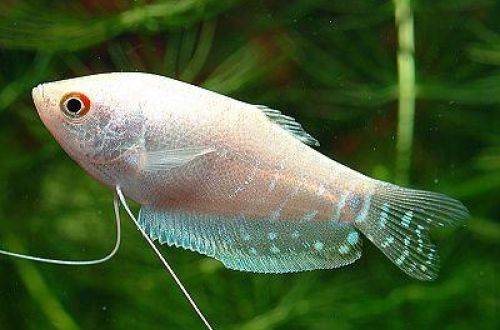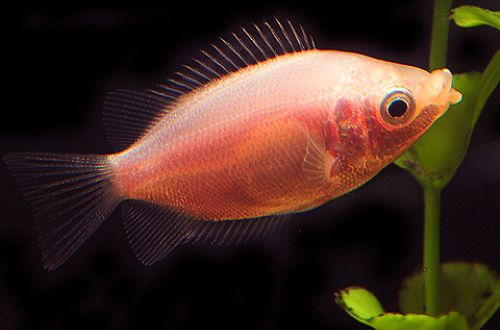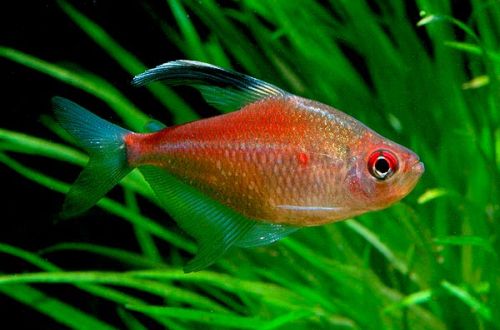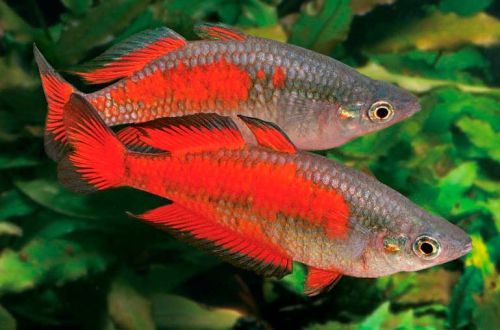
Platinum Gourami
The Platinum Gourami, scientific name Trichopodus trichopterus, belongs to the Osphronemidae family. A beautiful color variation of the Blue Gourami. It was bred artificially, by gradually fixing certain features over several generations. Despite the fact that this species is the result of selection, he was able to maintain the endurance and unpretentiousness of his predecessor.

Contents
Habitat
Platinum Gourami was bred artificially in the 1970s. not found in the US in the wild. Commercial breeding is organized mainly in Southeast Asia and Eastern Europe.
Description
These fish are similar to their predecessors in everything except color. Their body is predominantly white with soft yellow and silver undertones. On the back and abdomen, the pattern is more toned, it also extends to the fins with a tail. Sometimes two dark spots are visible – at the base of the tail and in the middle of the body. This is the legacy of the Blue Gourami.
Food
With pleasure they accept all types of dry industrial feed (flakes, granules). On sale are widely represented specialized feeds for gourami, combining all the necessary vitamins and minerals. As a supplement, you can include bloodworms, mosquito larvae and finely chopped pieces of vegetables in the diet. Feed once or twice a day, if you are feeding special food, then according to the instructions.
Maintenance and care
Due to the behavior of adult fish, it is recommended to purchase a tank of about 150 liters for two or three individuals. The minimum set of equipment consists of a filter, heater, aerator, lighting system. An important requirement for the filter is that it should create as little water movement as possible, but at the same time be productive. Gourami do not tolerate the internal flow, it causes stress and increased physical activity. Of great importance in the design of the aquarium are artificial shelters, grottoes, snags, as well as dense vegetation with areas of free space for swimming. Take care of unhindered access to the surface, thin out overgrown floating plants in time. The dark substrate favorably emphasizes the color of the fish, the size of the soil particles is not so important.
Social behavior
At a young age, they get along well with all peaceful species of fish, however, adults may be intolerant of their aquarium neighbors. The greater the number of fish, the higher the aggression, and the weaker male Gourami are attacked first of all. The preferred option is to keep a male/female pair or a male and several females. As neighbors, select proportionate and peaceful fish. Smaller species will be considered as prey.
Sexual differences
The male has a more elongated and pointed dorsal fin, in females it is noticeably shorter and with rounded edges.
Breeding / breeding
Like most Gourami, the male creates a nest on the surface of the water from small sticky air bubbles where the eggs are deposited. For successful breeding, you should prepare a separate spawning tank with a volume of about 80 liters or a little less, fill it with water from the main aquarium 13-15 cm high, the water parameters should match the main aquarium. Standard equipment: lighting system, aerator, heater, filter, giving a weak current of water. In the design, it is recommended to use floating plants with small leaves, for example, richia, they will become part of the nest.
The incentive for spawning is the inclusion of meat products (live or frozen) in the daily diet, after a while, when the female is noticeably rounded, the couple is placed in a separate tank, where the male starts building a nest, usually in the corner. Upon completion of construction, the male begins courtship – swims back and forth near the female, tail raised above his head, touches with his fins. The female lays up to 800 eggs in the nest, after which she moves back to the main aquarium, the male remains to protect the clutch, he joins the female only after the fry appear.
Fish diseases
In most cases, artificial species become more vulnerable to various diseases, however, this rule does not apply to Platinum Gourami, he retained high endurance and resistance to various infections. Read more about symptoms and treatments in the Aquarium Fish Diseases section.





